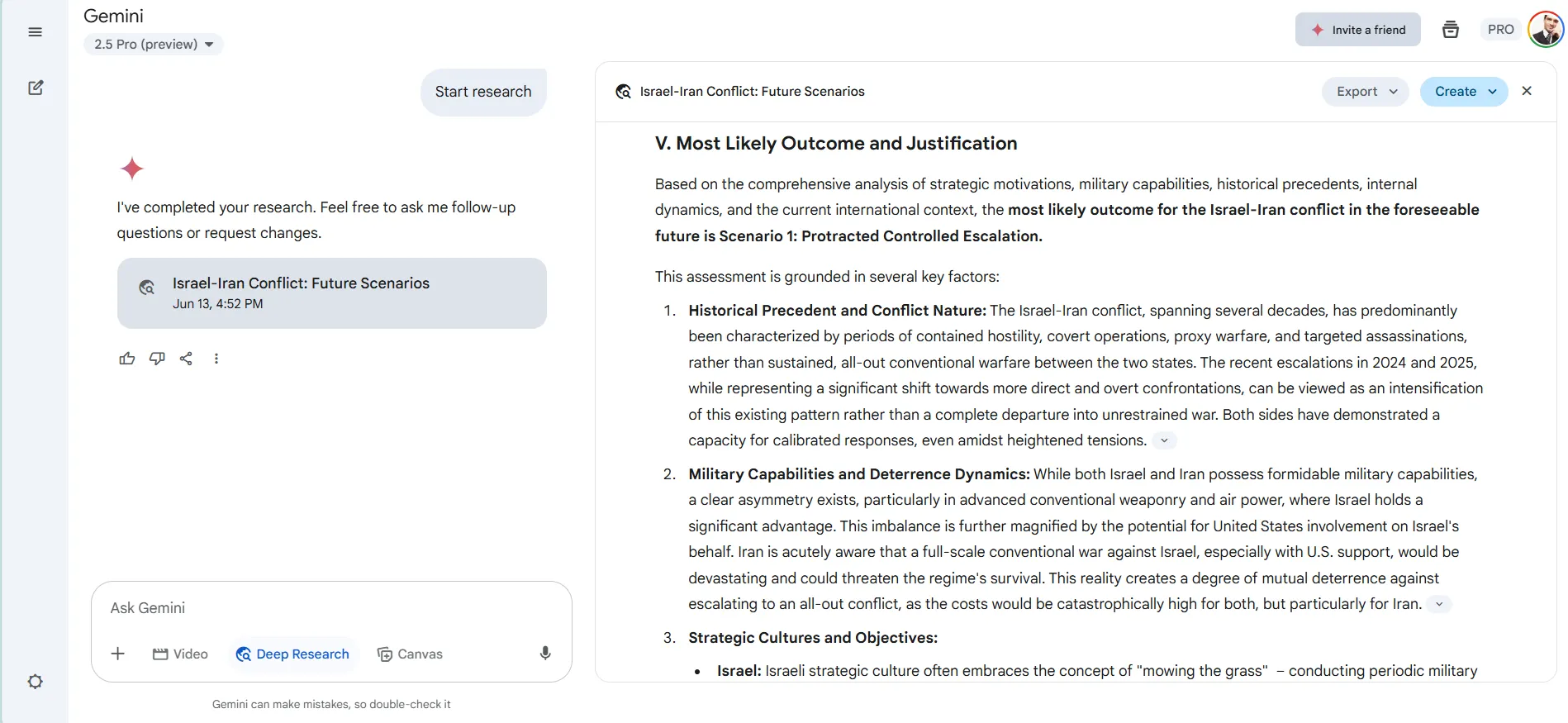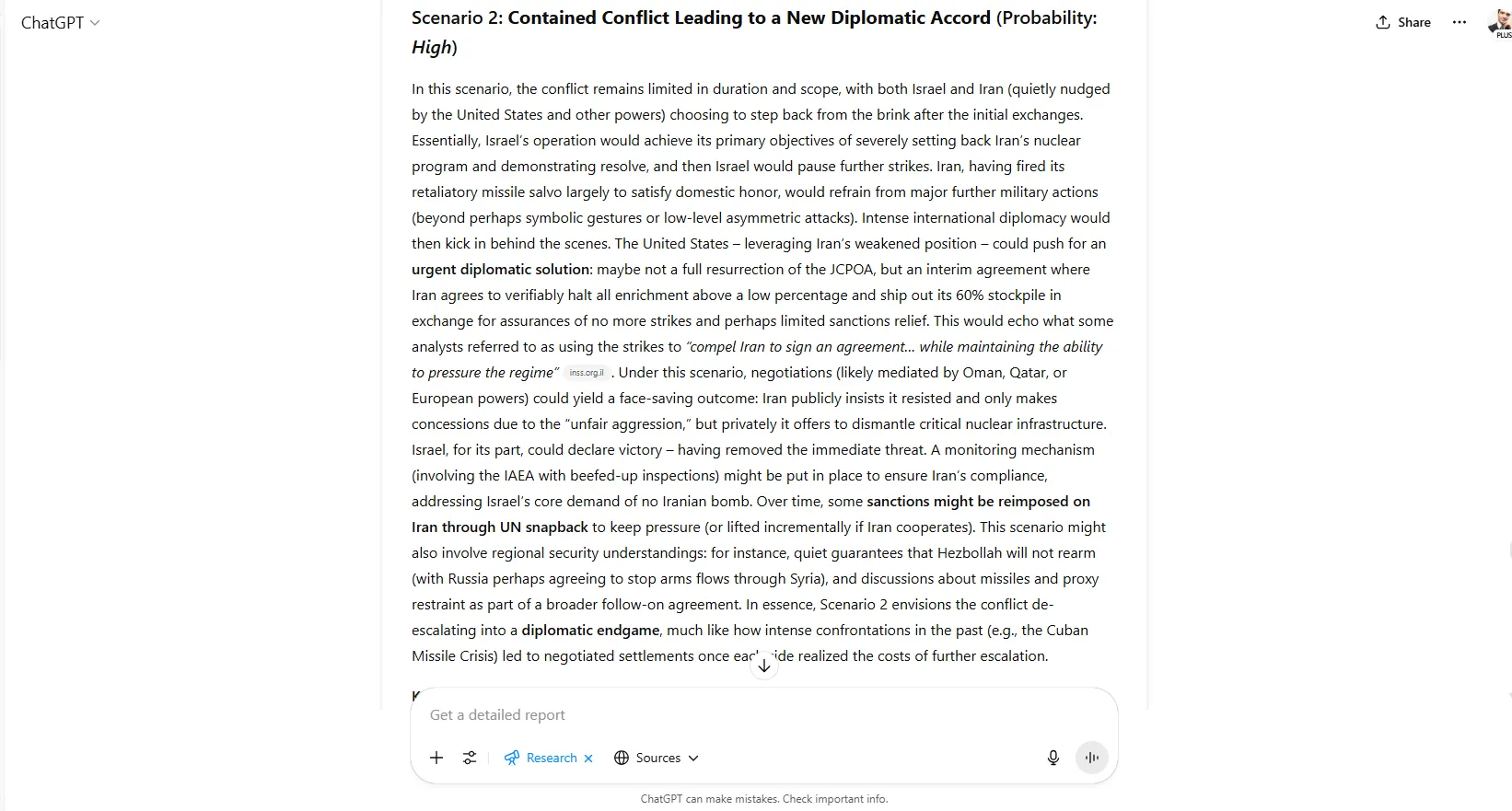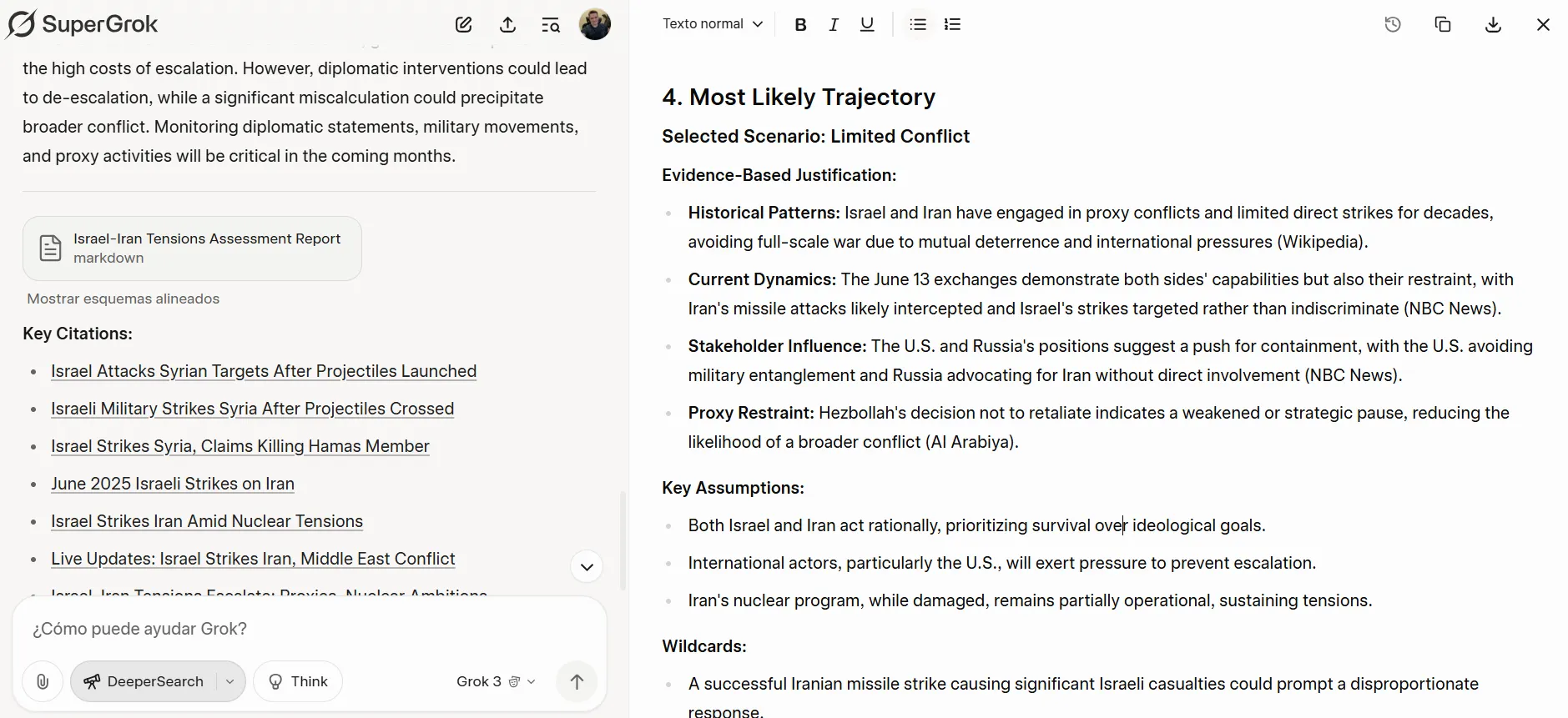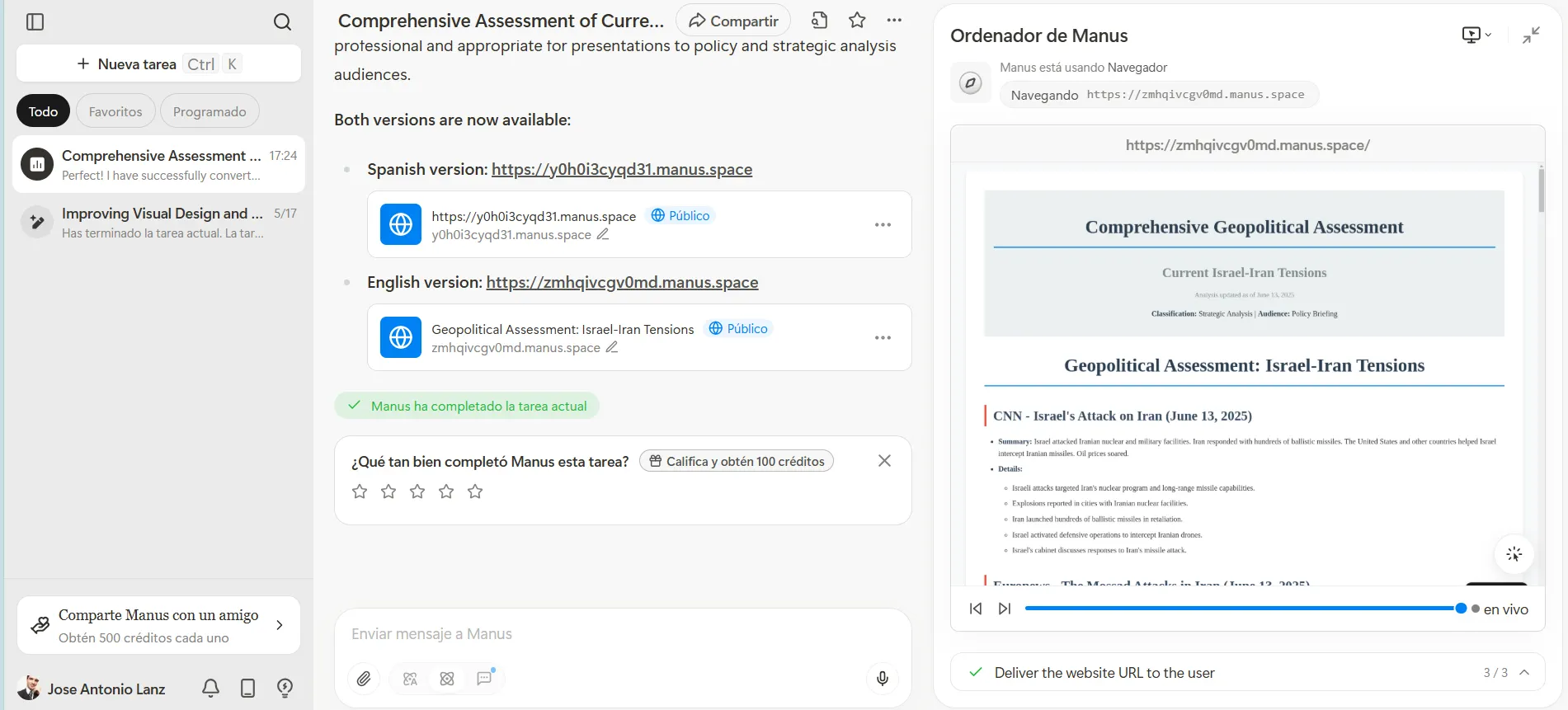In brief
- Six out of seven top AI models predict a prolonged shadow war between Israel and Iran, marked by airstrikes, cyberattacks, and proxy battles—but stopping short of full-scale war.
- Mutual deterrence, U.S. restraint, and survival instincts are seen as key forces preventing escalation, though all models warn of risks from miscalculation, nuclear pressure, and proxy overreach.
- Only ChatGPT forecasts a near-term diplomatic resolution, envisioning quiet negotiations and a revived nuclear deal—making it the lone optimist in a chorus of strategic pessimism.
With direct military confrontation now underway between Israel and Iran, we asked seven AI models to analyze potential outcomes using their web search functionalities, activating their deep reasoning capabilities and acting as experts in geopolitics, global warfare, and Middle East conflicts.
The consensus
Six of seven models predicted continued, intermittent warfare rather than diplomatic breakthrough or World War III. Only ChatGPT went full John Lennon mode and forecasted rapid negotiated resolution. The models agreed on key constraining factors: catastrophic consequences of full war, U.S. reluctance for direct involvement, and rational survival calculations by both sides.
Common warnings included miscalculation risks, nuclear timeline urgency, and potential for proxy groups to trigger unwanted escalation. Timeline predictions ranged from three to 24 months of sustained, low-intensity conflict.
As Manus, one of the first “agentic” AI systems summarized: “Elevated but manageable tensions: Rhetoric will often be belligerent, but actions will remain below the threshold of a large-scale open war.” The AI consensus suggests the shadow war will continue in daylight—more violent than before, but still governed by mutual deterrence and survival instincts.
Here’s what each model predicted, in more detail:
Google Gemini
- Most likely outcome: Protracted, controlled escalation.
- Timeframe: 12–24 months
- Key insight: Conflict will remain volatile and recalibrated with each strike; Israel will continue “mowing the grass” strategy of repeated tactical strikes.
- Warning: Red lines will erode over time, increasing risk of unintentional escalation.
Gemini produced the most comprehensive assessment, organizing its analysis into detailed scenarios with extensive historical context. The model identified three primary trajectories with careful probability assessments.
For its highest-probability scenario—”protracted, controlled escalation”—Gemini said: “The ‘control’ in this scenario is relative and subject to constant recalibration by both sides, making the situation volatile and unpredictable. Each escalatory cycle within this scenario will further test red lines and potentially erode existing restraints.”

The model referenced Israel’s “mowing the grass” doctrine, describing periodic military operations designed to degrade threats with small, but continuous attacks. Gemini projected this pattern would continue for 12-24 months, warning that “the cumulative effect of repeated strikes and retaliations can also lead to an erosion of previously respected red lines.”
“While the ‘protracted, controlled escalation’ scenario is deemed most likely, it is crucial to recognize that this is not a stable or benign state of affairs. It implies a persistent state of high tension, characterized by periodic military strikes, covert operations, cyber warfare, and proxy engagements,” it warned.
Anthropic Claude
- Most likely outcome: Sustained military campaign.
- Probability: 50–60%
- Key insight: Iran’s need to retaliate + Israel’s opportunity for decisive action = extended combat.
- Warning: Iran’s short breakout time (~25 days) could force strategic miscalculation or preemptive strikes.

Claude approached the crisis more like a military analyst than a diplomat, assigning specific probabilities and identifying concrete indicators for each scenario. The model gave “sustained military campaign” a 50-60% probability rating.
“Iran cannot accept nuclear program degradation without response, while Israel views current window as optimal for decisive action,” Claude stated. The model highlighted a critical factor: “Iran’s technical capability to rapidly weaponize creates potential for sudden strategic shift that could either deter further Israeli action or provoke preemptive escalation.”
Claude’s analysis included specific warning signs to monitor, from Strait of Hormuz closure attempts to uranium enrichment acceleration. The model noted Iran’s “25-day breakout capability” as providing both “escalatory leverage and urgency for decisive action.”
OpenAI ChatGPT
- Most likely outcome: Diplomatic resolution.
- Probability: High
- Key insight: Iran’s restrained retaliation and appeal to the UN indicate preference for diplomacy.
- Prediction: Quiet negotiations via Oman or Qatar; possible updated nuclear deal within weeks.

ChatGPT provided the most optimistic assessment, rating diplomatic resolution as “high probability” despite acknowledging severe military risks. The model outlined how escalation could unfold but consistently returned to negotiation possibilities.
“Tehran’s initial retaliation was symbolically fierce but ultimately limited in effect, suggesting a reluctance to escalate to a point of no return. The fact that Iran resorted to the UN and is engaging diplomatically (even if only to condemn Israel) shows it has not slammed the door on political paths,” ChatGPT observed. The model envisioned “quiet negotiations possibly mediated by Oman or Qatar, where Iran agrees to stringent limitations on its nuclear program.”
ChatGPT quoted President Trump’s statement that it’s “not too late” for a deal, interpreting this as evidence that “Washington is poised to broker such a settlement rather than pursue regime destruction.” The model predicted resolution within weeks through “a compromise–perhaps an updated nuclear accord.”
xAI Grok
- Most likely outcome: Limited conflict with periodic flare-ups.
- Timeframe: 3–6 months
- Key insight: Historical precedent favors avoidance of full-scale war; rational deterrence dominates.
- Warning: Wildcards include high-casualty strikes or new actors (e.g., Gulf states or Russia) entering the fray.

Grok’s research mode seems to have degraded in performance over the last weeks. We activated “Deeper Search,” which is supposed to use more resources for a more extensive report. However, the model delivered a super concise analysis focused on historical patterns and practical indicators. The model rated “limited conflict” as high probability based on precedent.
“Israel and Iran have engaged in proxy conflicts and limited direct strikes for decades, avoiding full-scale war due to mutual deterrence and international pressures,” Grok noted. The model projected 3-6 months of “periodic flare-ups of airstrikes, missile attacks, or proxy engagements.”
Grok identified specific wildcards including “a successful Iranian missile strike causing significant Israeli casualties could prompt a disproportionate response,” and potential “Gulf state or Russia escalating support.” The model emphasized that “both Israel and Iran act rationally, prioritizing survival over ideological goals.”
Manus
- Most likely outcome: Controlled escalation and shadow war.
- Probability: Medium–High
- Timeframe: 12–24 months
- Key insight: Pattern of targeted Israeli strikes and Iranian proxy response will continue.
- Emphasis: Indirect communication channels help avoid catastrophic misunderstandings.
Manus, one of the first agentic models, was a surprise. It not only executed a full research report, but was able to generate a website for easier understanding, and let us watch in real time amid the research process.
As an expert, Manus tried to be more nuanced in its assessment of Middle Eastern conflict dynamics, rating “controlled escalation and intensified shadow war” as medium-high probability over 12-24 months.

“This scenario reflects the historical pattern of confrontation between Israel and Iran, where both actors seek to inflict damage and deter each other without triggering an all-out war that neither can afford,” Manus explained. The model predicted Israel would “continue to carry out covert operations and selective airstrikes,” while Iran would respond “with a combination of missiles and drones, and through its proxies.”
Manus emphasized communication channels: “Although there is no direct dialogue, it is assumed that indirect channels exist (through third countries or intelligence) that allow both sides to communicate ‘red lines’ and avoid catastrophic misunderstandings.”
DeepSeek
- Most likely outcome: A prolonged, covert conflict between Israel and Iran.
- Probability: 60%
- Timeframe: Short-term (0–3 months) to mid-term (4–12 months)
- Key insight: Iran is strategically constrained and unlikely to engage in direct war.
- Emphasis or warning: Cyberwarfare and proxy actions will intensify without direct U.S. military involvement.

China’s DeepSeek does not have a research mode, but we combined its web search with reasoning capabilities. The result was a data-heavy analysis, assigning “protracted covert conflict” a 60% probability.
The timeline included granular predictions: “Short-Term (0-3 months): Iranian terror attacks in Europe; Israeli strikes on missile factories. Mid-Term (4-12 months): Cyberwar escalates; IAEA confirms Iranian uranium enrichment halt.”
DeepSeek noted constraints, including that “Iran lacks conventional capacity for direct war (air force outdated; proxies weakened)” and “U.S. avoids ground involvement; focuses on force protection.”
Generally Intelligent Newsletter
A weekly AI journey narrated by Gen, a generative AI model.







